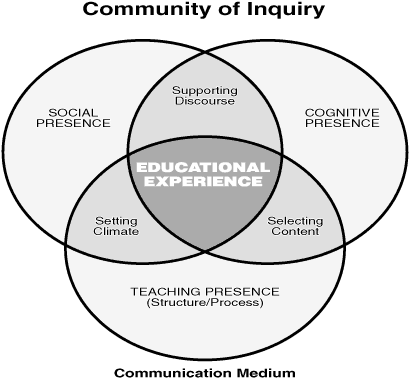Community of inquiry model: Difference between revisions
m (using an external editor) |
m (→The model) |
||
| Line 21: | Line 21: | ||
{{quotationbox | Note the pivotal role of social presence in not only setting the educational climate but also in supporting discourse and creating the educational experience. We defined social presence as "the ability of learners to project themselves socially and affectively into a community of inquiry" (Rourke, Anderson, Archer, & Garrison, 1999). We spent some time developing tools to measure social presence in asynchronous text conferencing systems and validating these tools via interviews and surveys (Rourke & Anderson, 2002). This work has been extended and quantified by a number of researchers (Tu, 2002; Stacey, 2002) demonstrating amongst other findings that social presence is correlated with student satisfaction and higher scores on learning outcomes (Richardson & Swan, 2003).}} | {{quotationbox | Note the pivotal role of social presence in not only setting the educational climate but also in supporting discourse and creating the educational experience. We defined social presence as "the ability of learners to project themselves socially and affectively into a community of inquiry" (Rourke, Anderson, Archer, & Garrison, 1999). We spent some time developing tools to measure social presence in asynchronous text conferencing systems and validating these tools via interviews and surveys (Rourke & Anderson, 2002). This work has been extended and quantified by a number of researchers (Tu, 2002; Stacey, 2002) demonstrating amongst other findings that social presence is correlated with student satisfaction and higher scores on learning outcomes (Richardson & Swan, 2003).}} | ||
Stephen | Stephen Downes made a suggestion to extend "presence" by "network". {{quotation | | ||
The COI exists within the larger context of the educational semantic web. I also envisioned the larger Net with all of its social, teaching and cognitive stimulation and support as being outside - but directly linking in to the three presences. Visualized as the whole the model immersed in the flow of the Net. Stephen's additions make that more clear and explicitly site the encompassing effect of the Net on learning and living these days.}} ([http://terrya.edublogs.org/2006/06/16/ples-getting-fleshed-out-conceptually-and-coi-model/ Virtual Canuck], retrieved 15:45, 6 July 2006 (MEST).) | |||
== Links == | == Links == | ||
Revision as of 22:05, 10 May 2007
Definition
The community of inquiry model is an instructional design model for e-learning developed by Randy Garrison and Terri Anderson. It's purpose is to provide a framework for the use of CMC in supporting an educational experience.
See also: social presence, community of practice, knowledge-building community model, community of learning, virtual community, social software
The model
“"A critical community of learners, from an educational perspective, is composed of teachers and students transacting with the specific purposes of facilitating, constructing, and validating understanding, and of developing capabilities that will lead to further learning. Such a community encourages cognitive independence and social interdependence simultaneously."” (Garrison & Anderson, 2003:23)
The community of inquiry model defines a good e-learning environment through three major components. On the communities of inquiry web site (retrieved 15:45, 6 July 2006 (MEST)) these are defined as follows:
- Cognitive presence is the extent to which the participants in any particular configuration of a community of inquiry are able to construct meaning through sustained communication. (COI/Cognitive Presence)
- Social presence is the ability of learners to project their personal characteristics into the community of inquiry, thereby presenting themselves as 'real people.' (COI/Social presence)
- Teaching presence is defined as the design, facilitation, and direction of cognitive and social processes for the purpose of realizing personally meaningful and educational worthwhile learning outcomes. (COI/Teaching presence))
The relationship and function of these components is explained in this picture
Stephen Downes made a suggestion to extend "presence" by "network". “The COI exists within the larger context of the educational semantic web. I also envisioned the larger Net with all of its social, teaching and cognitive stimulation and support as being outside - but directly linking in to the three presences. Visualized as the whole the model immersed in the flow of the Net. Stephen's additions make that more clear and explicitly site the encompassing effect of the Net on learning and living these days.” (Virtual Canuck, retrieved 15:45, 6 July 2006 (MEST).)
Links
- Communities of inquiry This site documents the work completed during a Canadian Social Sciences and Humanities research funded project entitled "A Study of the Characteristics and Qualities of Text-Based Computer Conferencing for Educational Purposes.
References
- Anderson, Terry (2005). Distance learning - social software's killer ap ?, 17th Biennial Conference of the Open and Distance Learning Association of Australia, 9-11 november 2005. [ http://www.unisa.edu.au/odlaaconference/PPDF2s/13%20odlaa%20-%20Anderson.pdf PDF]
- Garrison, D. R., Anderson, T., & Archer, W. (2000). Critical inquiry in a text-based environment: Computer conferencing in higher education. The Internet and Higher Education, 2(2-3), 87-105 PDF
- Garrison, D. R., Anderson, T., & Archer, W. (in press). Critical Thinking and Computer Conferencing:A Model and Tool to Assess Cognitive Presence. American Journal of Distance Education. PDF
- Garrison, Randy & Terry Anderson, (2003). E-Learning in the 21st Century: A Framework for Research and Practice, 2003, p. 23.
- Rourke, L. & Anderson, T. (2002). Exploring social presence in computer conferencing. Journal of Interactive Learning Research, 13(3), 259-275. PDF
- Richardson, J.C. & Swan, K. (2003). Examining social presence in online courses in relation to students' perceived learning and satisfaction. Journal of Asynchronous Learning Networks, 7 (1), pp.68-88.H
- Rourke, L., Anderson, T., Archer, W. & Garrison, D.R. (1999). Assessing social presence in asynchronous, text-based computer conferences. Journal of Distance Education, 14 (3), pp.51-70. PDF
- Stacey, E. (2002). Social presence online: Networking learners at a distance, education and information technologies. Education and Information Technologies, 7 (4), pp.287-294.
- Tu, C.H. (2002). The measurement of social presence in an online learning environment. International Journal on E-Learning, 1 (2), pp.34-45. pdf
